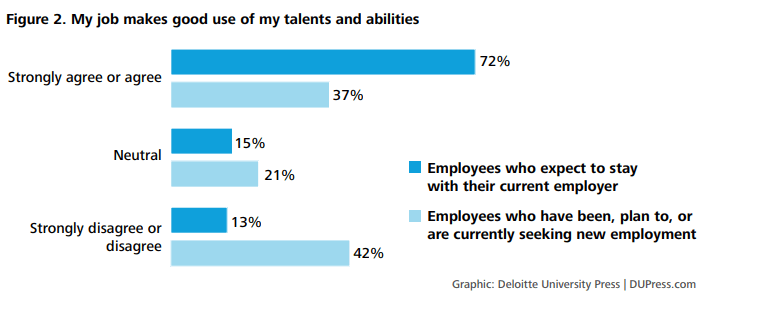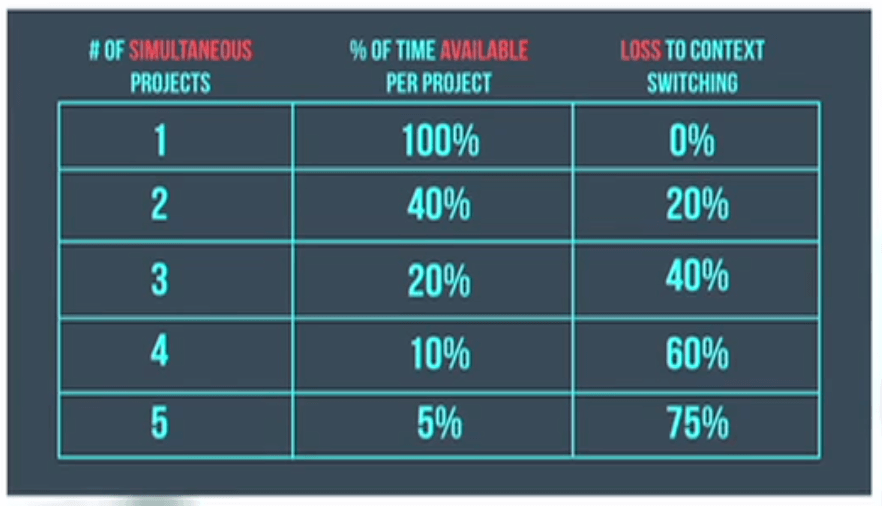Kate McDaniel is Blogs Editor at UiPath.
Think back to the last time you had a big project on a deadline. Were you able to focus 100% on the project and do your best work? Or did you have to split your time between priority tasks, administrative work, and the needs of your team?
If you weren’t able to give the project your full attention, you’re not alone—most people aren’t able to focus on truly productive work for more than a few hours a day.
Everyone, from the CEO to the newest administrative assistant, struggles to make the most of their time. It’s not a human resources (HR) problem—it’s a human problem.
This human problem also adds up to a financial problem. Wasted time and disengaged employees rack up trillions of dollars in lost productivity every year (and that’s just in the United States). Shiftboard even has a calculator you can use to help put an actual dollar amount to the cost of employee disengagement.
But before you can start getting that money back, you have to confront the real factors behind this lost productivity.
People are overloaded with information
Information overload happens when there’s so much data available that the brain literally can’t process it all. This affects the modern workforce in a major way.
People are bombarded daily with information from email inboxes, app notifications, and the internet. And that’s on top of all the information they need to get their job done. When this overload happens, employees’ ability to process tasks and make smart, quick decisions declines.
“Information overload decreases knowledge workers’ effectiveness and efficiency and causes diminished comprehension levels, compromised concentration levels, and reduced innovation,” Basex found in their report, Intel’s War on Information Overload: A Case Study.
Email is one of the top causes of information overload.
That’s unfortunate, considering how many work cultures reward constant availability, responsiveness, and inbox zero.
Constant connectivity might seem to boost productivity, but in the long run it erodes everyone’s ability to work well. And don’t think this is just a lower-level employee issue. A survey by Flock found that high-level executives are even more likely to suffer from information overload.
Is this just an unavoidable stress of modern work? Let’s hope not.
Mentally-fatigued workers (and executives) make a big dent in the bottom line. And not in a good way.
One report by First Monday ran the numbers and found that, for a company with roughly 50,000 employees, the problems caused by information overload will cost $1 billion per year. Harvard Business Review expands on this, estimating that productivity lost to information overload costs the United States (U.S.) economy $900 billion a year. Numbers like these can’t be ignored, especially in a recession.
This isn’t laziness—the people most susceptible to information overload are actually your top performers. The human brain can only process so many pieces of information per day. So make sure your employees are able to focus on the information that matters most.
People struggle to find meaning in repetitive work
Everyone wants to do meaningful work, the work that puts their talents and abilities to good use. But meaningful work isn’t just a nice perk, it’s essential to your worker’s ability to do their jobs well. (It’s also a deciding factor for whether they’ll stay with your company long term.)
Deloitte’s report, Talent 2020: Surveying the Talent Paradox from the Employee Perspective, shows a strong correlation between employees who find their work meaningful and those who plan to stay with their employer.

Source: Talent 2020: Surveying the Talent Paradox from the Employee Perspective
Despite the obvious importance of meaningful work, a global productivity study by Unit4 found that “on average, office workers spend approximately 552 hours a year (69 working days) completing administrative or repetitive tasks.”
This repetitive work is the opposite of meaningful work. It wastes your employees’ energy on unfulfilling, boring, and ultimately demotivating work.
“When employees don’t feel challenged, they tend to get bored, and when employees get bored, generally, their motivation levels decrease. Their degree of overall commitment toward the organization begins to suffer,” said Sheryl Kovach, President and CEO of Kandor Group, speaking with BenefitsPRO on how to boost employee engagement.
Not convinced yet?
Consider the results of a recent survey by Ashling Partners: 95% of respondents said they’d be more engaged if they thought their contributions mattered to the company’s success.
Employees who cannot engage in meaningful work cannot engage with their jobs.
The cost of disengagement is turnover, absenteeism, and lost productivity. And those are on top of the cost of paying employees to do low-value tasks in the first place.
Those costs add up:
When people can’t use their skills and creativity on the job, their work eventually goes stale.
To engage employees and shift focus to higher-value work, organizations must find a way to combat repetitive work.
People lose time to multitasking without realizing it
While most of us like to think we can effectively work on several tasks at once, humans aren’t actually capable of “multitasking.”
What we call multitasking is really context switching—moving our full attention from task to task very quickly. We look productive doing it, but this really makes us far less productive.
Context switching is one of the more invisible and dangerous factors affecting employee productivity. It not only hurts productivity, it hurts long-term intelligence and attention span as well.
The ugly truth? You don’t switch between tasks quickly when you’re multitasking, at least not in a meaningful way.
When you switch tasks—to respond to an interruption, check email, or take care of an urgent matter—it takes you almost half an hour to return your attention to the original task.
“To produce at your peak level, you need to work for extended periods with full concentration on a single task free from distraction. Put another way, the type of work that optimizes your performance is deep work,” says author Cal Newport in his book Deep Work: Rules for Focused Success in a Distracted World.
Unfortunately, many work environments make this kind of concentration very difficult, if not impossible. Disruptions like open office plans, push notifications, and the constant pressure to be responsive force most modern workers to multitask. These disruptions kill as much as 80% of employee productivity, even for people who work very hard.
It’s difficult to stay productive when surrounded by distractions competing for your attention, as any parent knows. According to The Cost of Not Paying Attention: How Interruptions Impact Knowledge Worker Productivity, a study by Basex, people lose an average of 2.1 hours of productive work to unimportant interruptions and distractions.
They lose even more time thanks to the effort it takes to refocus.
Based on those averages, Basex estimates 28 billion hours of productivity are lost per year in the U.S. alone.

Source: The Cost of Not Paying Attention: How Interruptions Impact Knowledge Worker Productivity
Multitasking and constant interruptions hurt people in many ways by increasing stress and lowering mental and creative capacity. This, of course, results in declining quality of work and both short- and long-term impacts on mental and physical health.
It’s just a fact: no one wins when employees don’t have the environment they need to focus on their priorities without distraction or interruption.
How you can tackle the factors affecting employee productivity
The price tags on information overload, repetitive work, and multitasking are high enough to get anyone’s attention. Both the problem and the solution come down to the environment. When people can work the way they’re wired to work, everyone benefits.
But to create that kind of environment, organizations need to rethink the way they do work. Here are some simple places to start:
Create guidelines to guard against information overload
We wish there was a way to magically cut down on the information bombarding your employees. But since there isn’t, the next best thing is creating frameworks for processing all that information.
Since email overload is one of the biggest factors affecting employee productivity, it’s an excellent place to start.
There are a few ways to help prevent information overload from email:
- Create rules for email. Rules such as when (and when not) to copy someone on an email or reply all will cut down on a lot of emails. Encourage employees to write actionable emails so that colleagues can process them efficiently.
- Create prioritization guidelines. Help employees understand how to prioritize important work instead of losing their focus to urgent but unimportant tasks (such as responding quickly to emails).
- Leverage tools to streamline email management. From simple inbox automation to full automation platforms, there are many ways you can use technology to reduce your employees’ mental load.
For more ideas, check out this great guide to handling information overload by Nathan Zeldes, Founder and President of the Information Overload Research Group.
Increase meaningful work and reduce repetitive work
Everyone would be happier if we could eliminate repetitive work tomorrow. But since that won’t happen, you’ll need to combat its negative effects instead. To do this, you must reduce repetitive work and increase meaningful work.
The specifics will look different for every company, but here’s where you can start:
- Build variety into your employees’ work. Studies have shown that workers who are able to change the sequence of repetitive tasks do not become bored or resentful as quickly. Make sure your employees have the freedom to vary their task schedules if possible.
- Audit your business processes. Inefficient processes lead to repetitive work. Review your organization’s workflows to look for silos, outdated systems, and redundancies. This will naturally cut down on repetitive work.
- Automate ‘robotic’ work. Employees who are stuck doing the same boring tasks all day often feel like robots. So why not add some software robots to the team to handle the repetitive work? Robots free your employees to focus on more meaningful, challenging work, and employee engagement will improve.
Emphasize mindfulness over multitasking
Multitasking fractures attention and prevents employees from doing their best work. To fix the damage caused by this constantly-distracted work state, you’ll need to replace your multitasking company culture with a mindful one.
- Let your employees know it’s OK to say no: It’s OK not to respond to emails right away; it’s OK to close your office door; it’s OK to book a conference room for yourself if you need to knock out a high-value project. Employees who are empowered to set boundaries are employees who can focus.
- Prioritize focused time spent on important work. Encouraging boundaries isn’t enough. Leaders must create a culture that emphasizes important work over “busyness.” Employees won’t pursue mindful work if your company rewards those who are “always on” over those who set thoughtful boundaries around their attention.
- Communicate priorities clearly. If leadership overloads employees with multiple projects and no guidelines for prioritization, employees will inevitably multitask. Instead, make expectations and priorities clear. Your workers will thank you with better focus.
It’s time to rethink work
We need to reevaluate the way we work. The evidence makes that very clear. Our current systems—from open office plans to how we handle email—too often run contrary to the environments that enable humans to do their best work.
A more engaged workforce is a more productive workforce. So let’s create that workforce.
By rethinking your organization’s approach to work and making cultural changes that support employees, you can save millions of dollars.
More importantly, you can build a company where employees are empowered to bring their best selves and do their best work. In this environment, there are no losers.
Learn more about how you can create a more productive, human organization with our Reboot Work ebook bundle.





